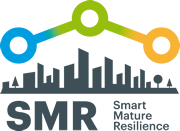Policies
Indicators
Percentage of local government budget spent on resilience building activities
Description
At this stage, incentives and investment are in place to foster resilience building. At this stage, the use of resources should be monitored.
Case Studies
Riga: Heat consumption data platform for 5000+ buildings
Summary
The objective of the project was to monitor use of heat consumption, providing development opportunities for heat-providers and multi-apartment house-management companies, as well as marketing tools for NGOs working with energy efficiency issues and ESCO companies providing renovation services.
Further information
Riga: Heat consumption data platform for 5000+ buildings
 Relevant city context
Relevant city context
This case study is of interest for cities aiming to set up city-wide monitor systems to, for example, increase efficiency. Riga is a city of approximately 650 000 inhabitants (1.5 million in Riga region), and is currently undergoing modernisation and effectivisation.
Goal: Monitor use of heat consumption to allow more effective use
The project was initiated 2013 by Riga Energy Agency in cooperation with municipal utility “Rigas Siltums” and municipal house management company “Rigas Namu Parvaldnieks”. The final product was a database based on data from 5100 building in Riga, containing annual heat energy consumption data and the values of annual effective specific heat consumption per unit of useful floor area. The database aimed to provide development opportunities for heat-providers and multi-apartment house-management companies, as well as marketing tools for NGOs working with energy efficiency issues and ESCO companies providing renovation services.
The project consisted of a pre-study resulting in a plan that could be presented to the municipality to gain political support for the idea. Following the positive response, a market study was performed and data was gathered. Once the database was launched several dissemination activities took place, such as brochures and handouts for citizens at various thematic events. Also, there were a series of info leaflets provided on municipal webpage.
Cooperation among stakeholders
Different open data solutions are a priority to the Riga 2030 Development strategy, and thus the political commitment to the project was high, enabling funding and other resources. It was foreseen already in the pre-study that gathering data from a large number of stakeholders (housing companies) may be a challenge. Lesson learned include the necessity of having a dedicated contact person in each company/service-provider and that all coordinators should have knowledge and background in both communication and energy. Further, it was noted that rather than provide tailor-made solutions, that is, adapting the project to local specifics, it is better to focus on a single task and only after considering other sub-tasks.
Outcomes
The project forced more rapid refurbishment and raised awareness across citizens on the topic of energy efficiency. There was a huge interest on the detailed data from ESCO, NGOs, local universities, research institutions and citizens. The database enabled the possibility to obtain information about energy consumption reduction in similar multi-apartment buildings after renovation and calculate potential savings, which was a moving force towards refurbishment.
It was found that working groups with citizens were more effective (in terms of feedback) if a certificate of completion was provided. It was also determined that the project would have benefitted from using social media for communication and marketing purposes, e.g. facebook and twitter. Toward the end of the project apps were developed and used during workshops for experts and house managers. It was agreed that if apps been developed within the first year of the project this would likely have increased the engagement from some of the stakeholders.
Resources
The total budget for the project was €50,000.
Laying the foundations for monitoring and evaluating a SUMP in Dresden (Germany)
Summary
To improve the mobility and quality of life for its citizens, Dresden developed a Sustainable Urban Mobility Plan (SUMP) to meet the mobility needs of residents, businesses and the region for decades to come.
Source: http://www.eltis.org/discover/case-studies/laying-foundations-monitoring-and-evaluating-sump-dresden-germany
Monitoring, reporting and evaluation approach in Helsinki Metropolitan Area MRE in New York: lessons to learn for Europe as well
Summary
The Helsinki Metropolitan Area adopted its adaptation strategy in 2012. It focuses on measures that address cross-sectoral or cross-municipal impacts of climate change and can produce synergies or efficiency gains through broader collaboration. One of the actions in the strategy is creating a system to monitor annually the implementation of measures, changes in the operational environment and reporting of implementation and changes
In 2010, the New York City Panel on Climate Change (NPCC) issued a report proposing the development of indicators and a monitoring system (Jacob et al., 2010). It recommended that the system cover a range of quantifiable indicators relating to physical climate change variables; risk exposure, vulnerability and impacts; adaptation measures; and new research in the previous three categories. This implies an active learning element and interest in benefiting from research findings and best practices from elsewhere. It emphasised that it is important for different actors (scientists, engineers, city officials) to collaborate in defining and selecting indicators.
Source: EEA, Box 5.36, Box 5.37
"Solecki, W., Rosenzweig, C., Blake, R., de Sherbinin, A., Matte, T., Moshary, F., Rosenzweig, B., Arend, M., Gaffin, S., Bou-Zeid, E., Rule, K., Sweeny, G. and Dessy, W., 2015, 'New York City panel on climate change 2015 report chapter 6: indicators and monitoring', Annals of the New York Academy of Sciences, 1336(1), pp. 89–106."
Subscribe to our newsletter

This project has received funding from the European Union’s Horizon 2020 research and innovation programme under grant agreement no. 653569.
